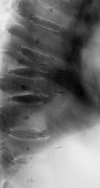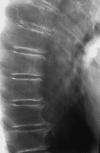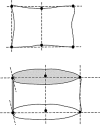Recognizing and reporting osteoporotic vertebral fractures
- PMID: 13680316
- PMCID: PMC3591834
- DOI: 10.1007/s00586-003-0613-0
Recognizing and reporting osteoporotic vertebral fractures
Abstract
Vertebral fractures are the hallmark of osteoporosis, and occur with a higher incidence earlier in life than any other type of osteoporotic fractures. It has been shown that both symptomatic and asymptomatic vertebral fractures are associated with increased morbidity and mortality. Morbidity associated with these fractures includes decreased physical function and social isolation, which have a significant impact on the patient's overall quality of life. Since the majority of vertebral fractures do not come to clinical attention, radiographic diagnosis is considered to be the best way to identify and confirm the presence of osteoporotic vertebral fractures in clinical practice. Traditionally, conventional lateral radiographs of the thoracolumbar spine have been visually evaluated by radiologists or clinicians to identify vertebral fractures. The two most widely used methods to determine the severity of such fractures in clinical research are the semiquantitative assessment of vertebral deformities, which is based on visual evaluation, and the quantitative approach, which is based on different morphometric criteria. In our practice for osteoporosis evaluation we use the Genant semiquantitative approach: an accurate and reproducible method tested and applied in many clinical studies. The newest generation of fan-beam DXA systems delivering "high-resolution" lateral spine images offers a potential practical alternative to radiographs for clinical vertebral fracture analysis. The advantages of using DXA over conventional radiographic devices are its minimal radiation exposure and high-speed image acquisition. It also allows combined evaluation of vertebral fracture status and bone mass density, which could become a standard for patient evaluation in osteoporosis. The disadvantage of DXA use is that upper thoracic vertebrae cannot be evaluated in a substantial number of patients due to poor imaging quality. We truly believe that the that there is a major role for radiologists and clinicians alike to carefully assess and diagnose vertebral fractures using standardized grading schemes such as the one outlined in this review. Quantitative morphometry is useful in the context of epidemiological studies and clinical drug trials; however, the studies would be flawed if quantitative morphometry were to be performed in isolation without additional adjudication by a trained and highly experienced radiologist or clinician.
Figures





References
Publication types
MeSH terms
LinkOut - more resources
Full Text Sources
Medical

